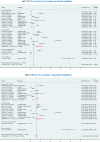The epidemiological burden and overall distribution of chronic comorbidities in coronavirus disease-2019 among 202,005 infected patients: evidence from a systematic review and meta-analysis
- PMID: 32813220
- PMCID: PMC7434853
- DOI: 10.1007/s15010-020-01502-8
The epidemiological burden and overall distribution of chronic comorbidities in coronavirus disease-2019 among 202,005 infected patients: evidence from a systematic review and meta-analysis
Abstract
Purpose: The main purpose of this study was to examine the overall distribution of chronic comorbidities in coronavirus disease-19 (COVID-19) infected populations and the risk of the underlying burden of disease in terms of the case fatality ratio (CFR).
Methods: We carried out a systematic review and meta-analysis of studies on COVID-19 patients published before 10th April 2020. Twenty-three studies containing data for 202,005 COVID-19 patients were identified and included in our study. Pooled effects of chronic comorbid conditions and CFR with 95% confidence intervals were calculated using random-effects models.
Results: A median age of COVID-19 patients was 56.4 years and 55% of the patients were male. The most prevalent chronic comorbid conditions were: any type of chronic comorbidity (37%; 95% CI 32-41%), hypertension (22%; 95% CI 17-27%), diabetes (14%; 95% CI 12-17%), respiratory diseases (5%; 95% CI 3-6%), cardiovascular diseases (13%; 95% CI 10-16%) and other chronic diseases (e.g., cancer) (8%; 95% CI 6-10%). Furthermore, 37% of COVID-19 patients had at least one chronic comorbid condition, 28% of patients had two conditions, and 19% of patients had three or more chronic conditions. The overall pooled CFR was 7% (95% CI 6-7%). The crude CFRs increased significantly with increasing number of chronic comorbid conditions, ranging from 6% for at least one chronic comorbid condition to 13% for 2 or 3 chronic comorbid conditions, 12% for 4 chronic comorbid conditions, 14% for 5 chronic comorbid conditions, and 21% for 6 or more chronic comorbid conditions. Furthermore, the overall CFRs also significantly increased with higher levels of reported clinical symptoms, ranging from 14% for at least four symptoms, to 15% for 5 or 6 symptoms, and 21% for 7 or more symptoms.
Conclusions: The chronic comorbid conditions were identified as dominating risk factors, which should be considered in an emergency disease management and treatment choices. There is urgent need to further enhance systematic and real-time sharing of epidemiologic data, clinical results, and experience to inform the global response to COVID-19.
Keywords: COVID-19; Chronic cormobidity; Coronavirus; Disease; Fatality.
Conflict of interest statement
The authors declared no conflicts of interest in this work.
Figures









References
-
- World Health Organization (WHO). Coronavirus (COVID-19). 2020. https://who.sprinklr.com/. Accessed 9 Apr 2020.
-
- World Health Organization (WHO). Report of the WHO-China joint mission on coronavirus disease 2019 (COVID-19). 2020.
-
- European Centre for Disease Prevention and Control . Novel coronavirus disease 2019 (COVID-19) pandemic: increased transmission in the EU/EEA and the UK—sixth update—12 March 2020. Stockholm: ECDC; 2020.
Publication types
MeSH terms
LinkOut - more resources
Full Text Sources
Medical
Miscellaneous

